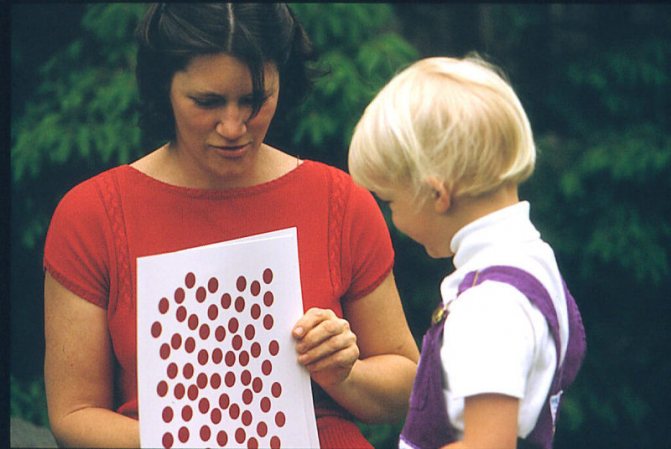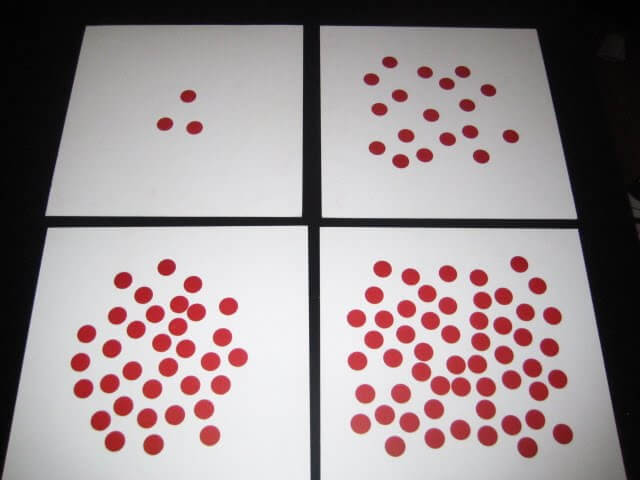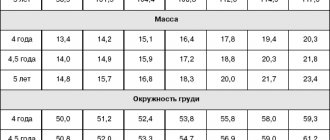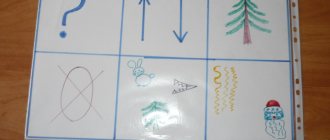Ideal age for learning
The learning system is clear, but how do we determine when our child is ready to learn?
3.1. From birth to three months
As soon as a child opens his eyes and sees this world, he begins to learn. This does not mean that he can immediately calculate complex equations in his head. At this time, the development of the visual functions of his brain occurs. We cannot begin “step one” without prior preparation. Let's call this "step zero".
It will be less about teaching mathematics and more about stimulating visual perception. The child does not immediately begin to see the details of objects. Mathematics classes with the child using the Doman system stimulate this ability. It's easy and even logical. We talk to the child from birth, and even for nine months before it.
“Step zero” involves showing the child cards with red dots from one to seven. The cards themselves should be one and a half times larger than regular ones, and the dots themselves should be larger too. The study area should be well lit. Show your child the card, say the number loudly and clearly, and wait. At this moment, the child will look for the card with his eyes. His attention at this age is good, but his eyesight is poor. However, don't try to catch his attention with the card. He will be distracted by a moving object and forget about what you told him.
On the first day of class, waiting for his attention to the card will take about fifteen seconds, but each subsequent time it will take less and less. Start by showing him the one dot card up to ten times on the first day.
On the second day - a card with two dots, etc. So, say, on Monday the child will see the “one” card, on Sunday - “seven”. Next week, repeat the process.
And so on for three weeks. Do not forget that the child must be in a good mood. For the fourth week, take new cards from eight to fourteen. After another three weeks, your baby will be ready to move on to “step one.”
3.2. Three to six months
At this age, the first two steps are well perceived. Focus on them. The child already recognizes details well and knows how to concentrate on them. He literally swallows all the information that is told to him loudly and clearly. At the same time, he himself communicates with us with sounds. How can you study mathematics with a child if he doesn’t even know how to speak? This is not necessary. Eyes and ears are the main organs of perception at this time. Basic rules - show cards quickly and update material more often.
3.3. Seven to twelve months
The frequency of sessions and the even greater speed of displaying cards is something worth remembering at this stage. A large amount of new information will result in disaster. At this age, the child begins to move, then crawl and finally walk, and a huge part of his attention is spent on the process of movement. This is no longer a three-month-old child who sits in one place and to whom you can show all new cards. Now it is extremely important not to distract the child from an important activity for a long time. He won't be able to look through fifty cards at a time. Five will be enough.
3.4. Twelve to eighteen months
At this stage, it is important not to forget about the brevity of the sessions and the need to stop before the child wants it. Listen to your baby. At this age, he is ready to easily perceive the first, second and third steps of the program. On the other hand, this is a time of even greater discoveries. He walks and runs more and more - and sits still less. That is why all sessions should be as short as possible.
3.5. Eighteen to thirty months
At eighteen months and older, it becomes increasingly difficult for a child to remember new information, so if you are starting a learning program at this stage, try to move to step five as quickly as possible. The first stages may seem too boring to the child. At this age, an open-minded attitude towards new information disappears. Now he may like something and not like something. The child begins to speak, realizes that he is understood, and forms a million demands. In this situation, it is worth teaching the material in such a way as to first interest him and then leave him a little “hungry”.
3.6. Over thirty months
The difference between a newborn baby and a child aged thirty months is enormous. This is no longer a child, and it is much more difficult for him to master quantity cards. You can still try the red dot cards, but the chance of learning them is low. However, this is not the end of the world. Not all mathematics consists of the ability to instantly solve complex arithmetic problems in your head. Focus on number cards and equations.
Doman method

2.1. The secret of the method
The secret of the method is to introduce the child to numbers and their true essence by showing him images with a certain number of red dots. For adults, the image of the number "three" as "3" or the image of three red dots are the same thing. The goal of the method is to teach the child to distinguish between them.
Adults can recognize up to twenty dots in a picture with more or less confidence. Any number greater than 20 can only be guessed at. Children can easily cope with this task if they are first taught the essence of numbers rather than their symbols .
If you name an adult a number, for example “six,” then he will rather imagine the number six, but not see six objects at all.
It's not that he won't "see" it. He will not understand that this is exactly the number of points in the picture. An adult needs to count all the points manually. The child sees the correct answer just by looking at the picture.
The ability to distinguish between “three” as “3” and “three” as three red dots will be an advantage for children over adults. You can teach your child mathematics, even if you yourself are not a master of this matter. It's even easier than teaching him to read. Moreover, the whole process will take no more than half an hour a day. Within just a few weeks you will notice progress.
It is important to remember the following points:
1. Until the age of five, a child easily absorbs a colossal amount of information.
2. Until the age of five, the child accepts all information.
3. The more information a child receives before the age of five, the more information remains.
4. Children under five years old have an enormous amount of energy.
5. Children under five years old have a great desire to learn.
6. Children under five years old can and want to learn to read.
7. All young children are brilliant linguists.
8. Before the age of five, they can learn an entire language or even several languages if you help them with it.
Math is also a language that your child can easily learn.
2.2. Basics of training
As a parent and teacher, you must learn that learning is the biggest adventure in a child's life . This is the most interesting game of all. You must keep this in mind throughout the entire process. Some people believe that we should not take away a child’s childhood by forcing him to study. This indicates a certain attitude towards learning. This is not work or punishment. If you or your child are not enjoying the process, then you are doing something wrong.
The game should be enjoyable, and if the child or parent is tired or in a bad mood, you need to postpone the process for a while.
It is also important to remember that the time for providing information should be as short as possible. For example, you can conduct such sessions two or three times a day, but the duration of each should be no more than a few seconds. You must stop until your child wants it.
Adults expect children to look at learning material, concentrate on it, and try to remember it. Children don't need this; they pick up information on the fly. Speed, new material and a good mood from parents is all that is needed.
You will be surprised how hungry your child will be for new information when you start teaching. Let him guide you. Don't let him get bored. There is nothing more boring than learning the same examples by heart.
Be consistent - prepare all the training material in advance, and if you had to postpone the session, then when the time comes to continue, do not return to what has already been completed. Continue where you left off. And never try to check the mastery of the material, do not test your baby. All tests are perceived as something unpleasant.

The training material is very simple:
1. White cards of 30 x 30 cm format. For the first time, you will need at least 100 pieces, so it will be more convenient to buy ready-made ones and not waste precious time on cutting.
2. Red dots on adhesive paper with a diameter of approximately 2 cm. The red color attracts babies.
3. Thick red marker , the thicker the better.
It will take time to prepare the material, but overall it is not at all difficult. There is a ready-made set of cards with dots from one to one hundred, developed by the publisher. But if you couldn’t find it, here are some tips to simplify the task:
1. Start with the “hundred” card and continue in descending order. The greater the number of points, the more difficult it is. We tend to be more focused and attentive in the beginning.
2. Count the red dots before placing them on the card.
3. On the back of the card, write a value in each corner before gluing the dots onto the card.
4. Make sure that the pasted dots do not resemble any shape (for example, a square or triangle).
5. Glue the dots onto the card so that they do not overlap each other.
6. Leave margins so your fingers don't cover the dots when you hold the card.
2.3. Step 1: Quantity Recognition
The first thing you need to start learning mathematics is to learn the denomination or the essence of numbers . For the first lessons, cards with values from one to ten will be enough. For one session you need only five cards. Wait until the child is in a good mood and nothing bothers him. Choose a place where the child will not be distracted. TV, radio - everything needs to be turned off.
Take a card with one dot. Show it to your child and say loud and clear, “This is one.” Don't linger. Say the phrase just long enough to say it. Then remove the card with one dot, take out the card with two and say: “That’s two,” and so on until five. Watch your child carefully. Don't ask your child to repeat numbers. Hug and kiss him. Let him understand that you really enjoy this joint process. This is one session. Repeat it three times during the day.
The next day, show your child cards six to ten. Also give praise at the end of each session. Don't bribe him with sweets. Once you have shown the cards in ascending order, mix them up and show the cards in random order during subsequent sessions. It is extremely important not to hesitate. Children remember information with lightning speed.
Show your child cards from one to ten for five days, shuffling them, then add a couple of new cards (next in order) and remove the same number of old ones (one, two, three, etc.). It is important to remember the basic rule - the child should not be bored! If he gets bored, you slowly show the cards.
It is enough to learn cards from one to one hundred so that the child can immediately understand how many dots are in the picture - twenty-eight or twenty-nine. It's so simple. Now he won’t need to remember the ill-fated phrase “we write two, one in our mind.” He will understand what we are talking about. He will “see” the real quantity hidden behind the number. You will be tempted to test what you have already learned. Do not do that. You may scare your child and he will lose interest in learning.
2.4. Step 2: Arithmetic operations
Perhaps even before your child masters 100, he or she will be ready for the next step— simple arithmetic . For the study material, take ready-made cards and write on the back a series of examples of addition, subtraction, multiplication and division.
Start with addition. This is the simplest example because the child is already familiar with it. When you showed him the cards in ascending order, you were essentially adding one to each card.
Take three cards and place them face down on your lap. Then, while saying the equation, start showing the cards. For example, “one” (show the “one” card) “plus two” (show the “two” card) “equals three” (show the “three” card). Say the entire phrase loudly and clearly. At this stage, there is no need to explain to your child the meaning of the words “plus” and “equals”. He himself will understand them along the way. It is important to use the same terminology all the time.
Show three equations per session, for a total of nine examples per day. Don't repeat examples. Learn addition for two weeks.
The same principle applies to other arithmetic operations.
2.5. Step 3. Solving examples
As has been said many times, don't try to test your child. Children love to learn, but hate tests. The learning process can either drag on or stop completely. The child will suspect that you do not believe that he can solve this or that example until he proves it to you. Essentially, this is an attempt to find out what the child does not know, but you, in turn, know.
Instead, you need to give your child a chance to prove himself. Offer him to solve the problem. For example, take two cards “thirty-eight” and “twelve”, show them to the child and ask: “Where is thirty-eight?” Have your child look at or touch the correct card. If the child does not answer immediately, present the correct card and ask again: “That’s thirty-eight, right?”
Add one example of this to each training session. This way you will alternate numbers, arithmetic operations and solving examples.
To keep your child engaged, add variety to your equations. For example, you can create a number of examples with a similar component.
- 4 x 3 x 5 = 60
- 3 x 5 x 4 = 60
- 5 x 3 x 4 = 60
At this stage, it is important not to mix addition and subtraction with multiplication and division, in order to avoid mistakes. Add up to four components per example, and you will be surprised how quickly your baby will learn to cope with them.
More advanced parents can continue to teach their child other arithmetic functions—arithmetic and geometric progressions, greater than and less than, inequalities, and basic algebra.
2.6. Step 4. Digit recognition
Once a child has learned to understand the quantitative essence, you can teach him to recognize the numbers themselves, namely the graphic display of numbers, as we adults are used to seeing them. To do this, you need to take the blank cards we already know and write the numbers from one to one hundred with a black marker. Be consistent and attentive. The numbers should be visually the same size, approximately 15 cm in height and 8 cm in width. The learning principle is similar to the first step. You will need no more than fifty days to study numerals. You can add examples of numerals greater than a hundred - 200, 300, 400, etc., as well as non-round numerals - 258, 369, 1256, etc.
Once your child has mastered the numbers, mix up the dot and number cards and create their own equations. Show him a card with a familiar number, say, “twelve,” and say it out loud. Then say “equals” and show a card with twelve red dots, say “twelve”.

This step is usually the easiest for the child.
2.7. Step 5. Equations with numerals
This step repeats all the previous ones with only one difference. Now the equations involve the numbers we are used to. For equations with numerals you will need new rectangular cards, 45cm long and 10cm wide, with a smaller font. Something like this:
25 + 5 = 30
Always have the correct answer handy. The child should not see your doubts in finding the right answer.
When you go through all the steps with your child, you can consider that you have opened the doors to the magical world of mathematics, where he will feel like a fish in water.






